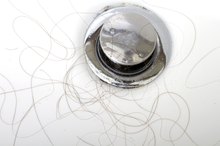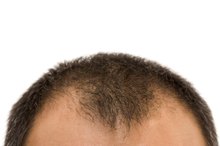Post-Menopause Facial Hair
Menopause ushers in many changes in your body 6. While no longer having monthly periods may come as a welcome change, growth of some facial hair on your chin or upper lip usually isn't. Troubling as it may be, sprouting sparse facial hair after menopause is not unusual, and there are several treatment options available that should help improve this problem.
Symptom
There are several types of human hair, all produced by hair follicles. Women of all ages have abundant hair follicles on their faces, and these normally produce soft hairs that are generally unnoticeable. But around the time of menopause and thereafter, you might notice some coarse hairs growing on your face -- usually on your chin or upper lip. These hairs, known as terminal hairs, grow because of changes in the levels of male and female hormones in your body associated with menopause.
- There are several types of human hair, all produced by hair follicles.
- Women of all ages have abundant hair follicles on their faces, and these normally produce soft hairs that are generally unnoticeable.
Cause
Menopause & Underarm Hair
Learn More
During your childbearing years, your ovaries produce large amounts of the female hormone estrogen as well as a small amount of the male hormone testosterone. When menopause arrives, your ovaries' production of estrogen drops considerably but small amounts of testosterone continue to be made for several years. Your adrenal glands also produce small amounts of male hormones throughout your life. Therefore, menopause tips the balance between your male and female sex hormone levels. This relative excess of male hormones can trigger the growth of sparse, coarse facial hair.
- During your childbearing years, your ovaries produce large amounts of the female hormone estrogen as well as a small amount of the male hormone testosterone.
- Therefore, menopause tips the balance between your male and female sex hormone levels.
Prevalence
An article published in the March 2011 issue of the "British Journal of Dermatology" reported that in a group of post-menopausal women aged 45 or older, 39 percent experienced excess growth of facial hair, mostly on the chin 5. Another October 2009 study report published in "Menopausal Health" noted that among a group of 656 American women aged 50 to 79, extra hair -- almost exclusively on the face -- was present in 33 percent of women aged 50 to 59, and 54 percent of women 60 to 69 5. The researchers found no significant differences in facial hair growth between Caucasian and African-American women.
What to Do
What Causes Lip Hair Growth?
Learn More
If you have just a few facial hairs, cutting or removing them with tweezers is a simple solution. But if the hair is excessive and disturbing, see your doctor to discuss other options. These might include use of a topical cream called eflornithine (Vaniqa) that slows hair growh. Other treatments include electrolysis, which destroys hair follicles with an electrical current or heat, or removal of hair with a special laser. Combining laser treatment with use of eflornithine cream might lead to more complete hair removal, according to the authors of a research study published in the July 2007 issue of the "Journal of the American Academy of Dermatology. 7"
- If you have just a few facial hairs, cutting or removing them with tweezers is a simple solution.
- Combining laser treatment with use of eflornithine cream might lead to more complete hair removal, according to the authors of a research study published in the July 2007 issue of the "Journal of the American Academy of Dermatology.
Warning
The gradual growth of sparse facial hair after menopause is not a threat to your health. However, the development of a lot of facial and/or body hair relatively quickly might signal a medical problem. For example, a disorder called Cushing syndrome causes the adrenal glands to secrete too much male hormone. Testosterone-producing tumors of the ovary or adrenal gland can also cause excess hair growth. These conditions are rare and may develop at any time, including after menopause. See your doctor as soon as possible if you notice sudden or extensive growth of facial or body hair.
- The gradual growth of sparse facial hair after menopause is not a threat to your health.
- However, the development of a lot of facial and/or body hair relatively quickly might signal a medical problem.
Related Articles
References
- NIH News in Health: Mystified by Menopause?
- Cleveland Clinic Center for Continuing Education: Hirsutism
- Biomed Research International: Alterations in Hair Follicle Dynamics in Women
- American Academy of Dermatology: Treating Excess Body Hair Could Remedy a Hairy Situation
- British Journal of Dermatology: Physiological Changes in Scalp, Facial and Body Hair After the Menopause -- A Cross-Sectional Population-Based Study of Subjective Changes
- Journal of the American Academy of Dermatology: A Randomized Bilateral Vehicle-Controlled Study of Eflornithine Cream Combined with Laser Treatment Versus Laser Treatment Alone for Facial Hirsutism in Women
- American Family Physician: Evaluation and Treatment of Women With Hirsutism
- Medicine (Baltimore): Androgen Dependence of Hirsutism, Acne and Alopecia in Women -- Retrospective Analysis of 228 Patients Investigated for Hyperandrogenism
- TeensHealth from Nemours. Hair removal. Updated August 2016.
- National Organization for Rare Disorders. Trichotillomania.
- NIH MedlinePlus. Depilatory poisoning. Updated April 9. 2020.
- Michigan Medicine. Electrolysis for removing hair. Updated October 30, 2019.
- American Academy of Dermatology. Laser hair removal: FAQs.
- USFDA. Vaniqa™. Updated July 27, 2000.
- Hamzavi I, Tan E, Shapiro J, Lui H. A randomized bilateral vehicle-controlled study of eflornithine cream combined with laser treatment versus laser treatment alone for facial hirsutism in women. J Am Acad Dermatol. 2007;57(1):54-9. doi:10.1016/j.jaad.2006.09.025
- Hamzavi, I., Tan, E., Shapiro, J., Lui, H. (2007). A randomized bilateral vehicle-controlled study of eflornithine cream combined with laser treatment versus laser treatment alone for facial hirsutism in women. J Am Acad Dermatol, Jul, 57, 1, 54-9.
- Wanitphakdeedecha, R., Alster, T.S. (2008). Physical means of treating unwanted hair. Dermatol Ther, Sep-Oct, 21, 5, 392-401.
Writer Bio
Joanne Marie began writing professionally in 1981. Her work has appeared in health, medical and scientific publications such as Endocrinology and Journal of Cell Biology. She has also published in hobbyist offerings such as The Hobstarand The Bagpiper. Marie is a certified master gardener and has a Ph.D. in anatomy from Temple University School of Medicine.









